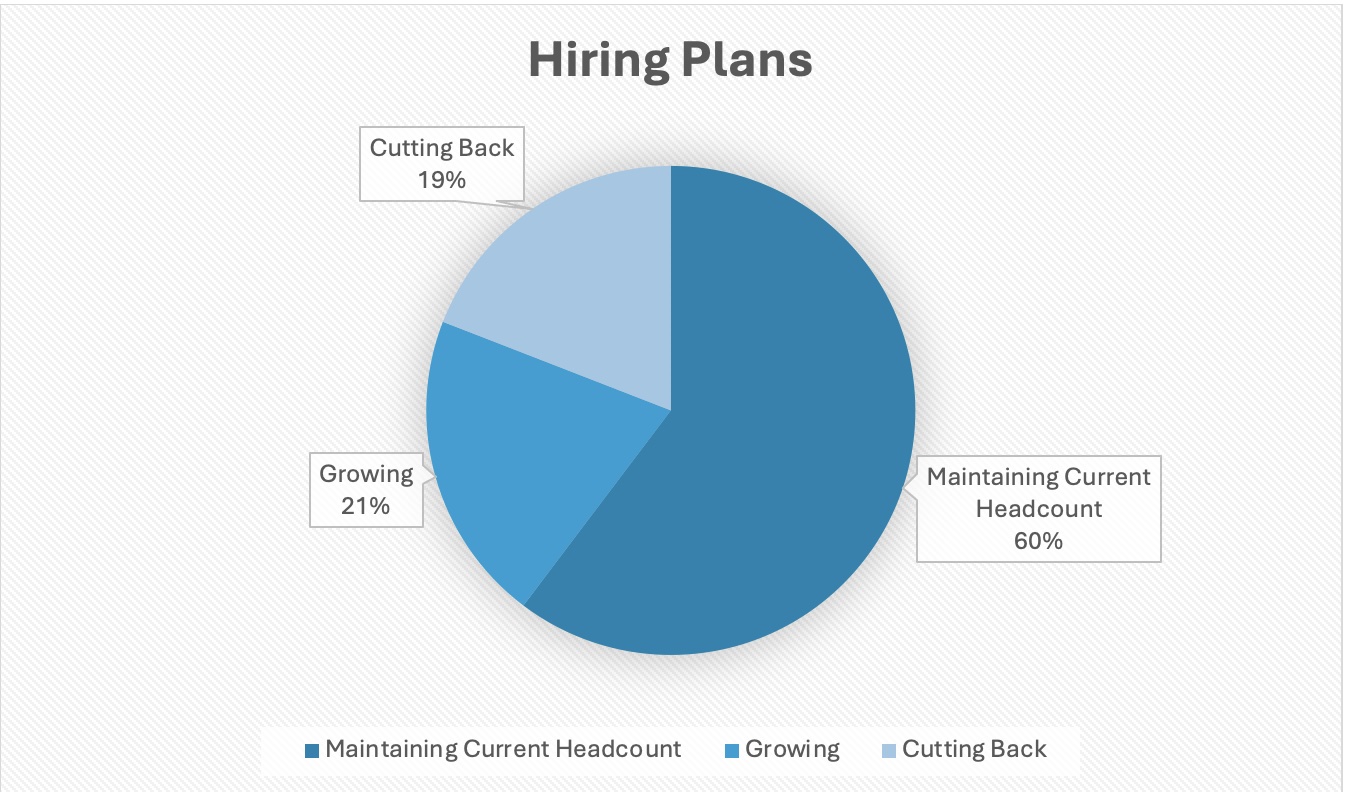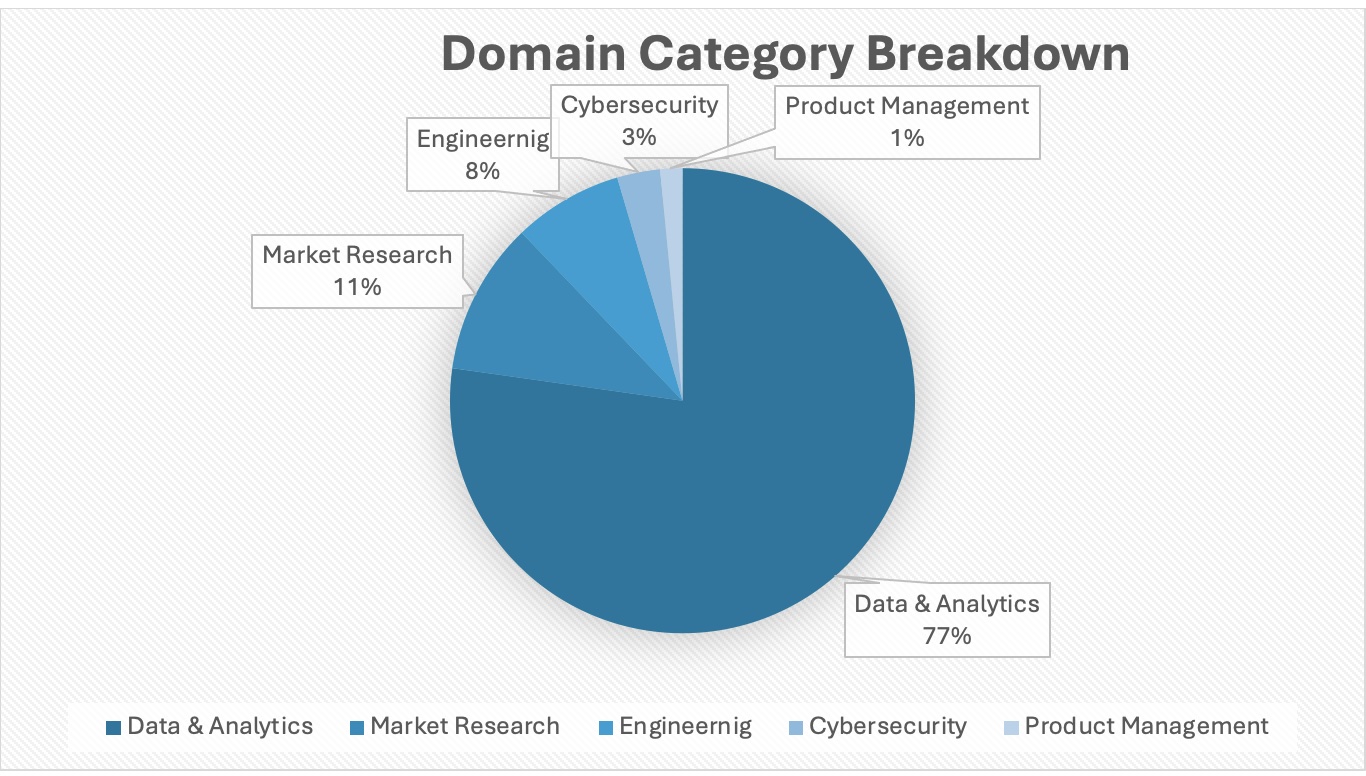Burtch Works Hiring Trends for 2025 2H: Strategic Growth, Stability & Skills in Demand
As we enter the second half of 2025, the hiring landscape across Data Science, Analytics, AI, Market Research, Product, Engineering, and Cybersecurity reflects a delicate balance between cautious stability and targeted expansion. Organizations are navigating macroeconomic uncertainty, talent retention challenges, and evolving skill requirements—resulting in smaller, more intentional hiring efforts.
Our 2H 2025 Hiring Survey provides an in-depth look at how companies are approaching staffing decisions, the types of roles in demand, and the skills they value most in new hires.
Key Hiring Insights for 2H 2025
- Most Companies Are Holding Steady

Survey finding: 60.3% of respondents are maintaining current headcount, focusing on replacing departing employees rather than adding net new positions. Only 20.6% are in growth mode, while 19.1% are cutting back—highlighting the continued prevalence of conservative workforce management.
What This Means for Employers:
While expansion is happening, it is targeted rather than broad-based. Employers should:
- Prioritize employee retention to reduce costly backfills.
- Build proactive pipelines so that critical roles can be filled quickly.
- Align new hires to measurable business outcomes to justify each addition.
- Data & Analytics Still Dominate—but Other Domains Are Rising

Survey finding: 75% of hiring activity is for Data & Analytics roles, but demand is also notable in:
- Market Research – 10.3%
- Engineering – 7.4%
- Cybersecurity – 2.9%
- Product Management – 1.5%
What This Means for Employers:
Data & Analytics continues to be the cornerstone of hiring, but companies are also investing in insights, infrastructure, and security capabilities. This shift suggests:
- A move toward holistic data ecosystems—not just analytics, but also the architecture, research, and protection needed to support it.
- An opportunity to cross-train analytics professionals into adjacent areas such as data engineering or cybersecurity, where skill overlap exists.
- Hiring is Small-Scale and Precision-Driven
Survey finding: Of those planning to hire, 96% will add only 1–5 employees. Only 4% plan larger expansions (11–20 hires).
What This Means for Employers:
This precision approach means:
- Speed matters—slow hiring processes risk losing top talent.
- Well-defined job descriptions can help filter candidates efficiently.
- Budget approvals should be aligned with business-critical needs to avoid stalled searches.
- Full-Time Roles Remain Preferred, But Agility is Valuable
Survey finding: 67.7% prefer full-time permanent hires, while 29% use a mix of full-time and contract staff, and 3.2% rely exclusively on contract hires.
What This Means for Employers:
While long-term hiring is the default, agility is key:
- Contract-to-hire models provide flexibility and reduce risk.
- Fractional hiring or specialized contractors can fill gaps for project surges or experimental initiatives.
- Organizations that combine stability with agility will be best positioned to adapt to shifting priorities.
- Turnover is the Leading Driver of Hiring
Survey finding: 59.3% of hires are replacements due to turnover, compared to 18.6% for growth and 17% for skill-gap fills.
What This Means for Employers:
Retention has direct budget implications. To reduce backfill needs:
- Invest in career pathing and internal mobility programs.
- Create employee engagement strategies to improve satisfaction.
- Maintain a bench of ready-now talent for mission-critical roles.
- Technical and Problem-Solving Skills Take Top Priority
Survey finding (average rank; lower = higher priority):
- Technical expertise – 1.40
- Problem-solving & critical thinking – 2.63
- Soft skills & emotional intelligence – 3.00
- Culture fit – 3.93
- Industry-specific experience – 4.06
What This Means for Employers:
Companies value capability over familiarity—they’re more willing to train on industry nuances if candidates bring strong technical and cognitive abilities. Employers should:
- Use skills-based assessments in hiring.
- Source from adjacent industries to expand candidate pools.
- Maintain upskilling programs to strengthen analytical and technical competencies internally.
Overall Trend
In 2H 2025, hiring is measured, deliberate, and skills-first. The focus is on sustaining performance, closing technical gaps, and replacing lost talent—rather than scaling teams rapidly. The employers who win in this environment will combine operational stability with adaptable staffing models and a commitment to retention.
How Burtch Works Can Help
With over 16 years of deep specialization in Data & Analytics, Burtch Works partners with organizations to deliver the right talent for business-critical needs. Our 150K+ vetted talent network and customizable search and staffing solutions can help you:
- Backfill key roles quickly to maintain productivity
- Add specialized contract talent for high-impact projects
- Develop a long-term hiring roadmap aligned to strategic goals
Ready to strengthen your team for 2H 2025 and beyond?


